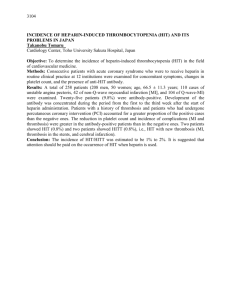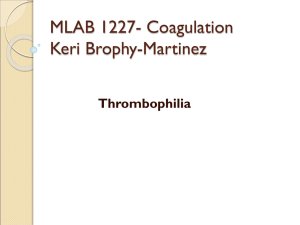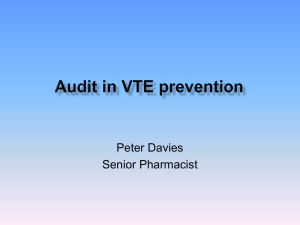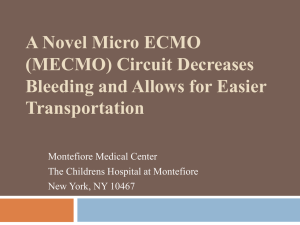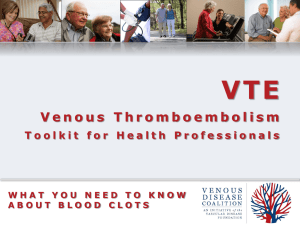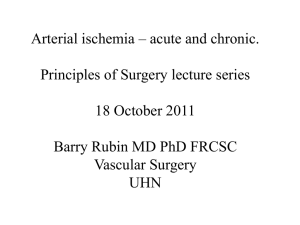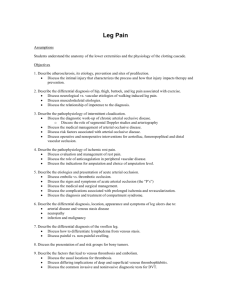word format
advertisement
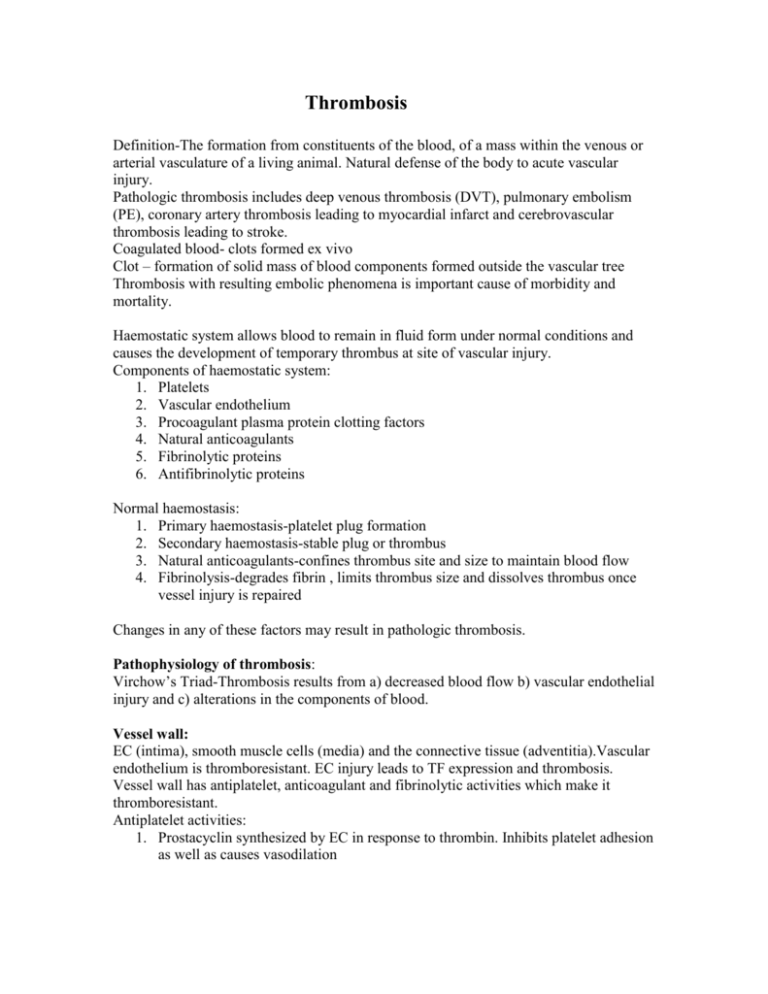
Thrombosis Definition-The formation from constituents of the blood, of a mass within the venous or arterial vasculature of a living animal. Natural defense of the body to acute vascular injury. Pathologic thrombosis includes deep venous thrombosis (DVT), pulmonary embolism (PE), coronary artery thrombosis leading to myocardial infarct and cerebrovascular thrombosis leading to stroke. Coagulated blood- clots formed ex vivo Clot – formation of solid mass of blood components formed outside the vascular tree Thrombosis with resulting embolic phenomena is important cause of morbidity and mortality. Haemostatic system allows blood to remain in fluid form under normal conditions and causes the development of temporary thrombus at site of vascular injury. Components of haemostatic system: 1. Platelets 2. Vascular endothelium 3. Procoagulant plasma protein clotting factors 4. Natural anticoagulants 5. Fibrinolytic proteins 6. Antifibrinolytic proteins Normal haemostasis: 1. Primary haemostasis-platelet plug formation 2. Secondary haemostasis-stable plug or thrombus 3. Natural anticoagulants-confines thrombus site and size to maintain blood flow 4. Fibrinolysis-degrades fibrin , limits thrombus size and dissolves thrombus once vessel injury is repaired Changes in any of these factors may result in pathologic thrombosis. Pathophysiology of thrombosis: Virchow’s Triad-Thrombosis results from a) decreased blood flow b) vascular endothelial injury and c) alterations in the components of blood. Vessel wall: EC (intima), smooth muscle cells (media) and the connective tissue (adventitia).Vascular endothelium is thromboresistant. EC injury leads to TF expression and thrombosis. Vessel wall has antiplatelet, anticoagulant and fibrinolytic activities which make it thromboresistant. Antiplatelet activities: 1. Prostacyclin synthesized by EC in response to thrombin. Inhibits platelet adhesion as well as causes vasodilation 2. NO regulates vascular tone as well as functioning as inhibitor of platelet adhesion. Constitutive expression as well as induced expression by EC in response to cytokines 3. Ectozymes which metabolize ADP and ATP to AMP and adenosine. Adenosine inhibits platelet function, ADP is platelet agonist Anticoagulant activities: 1. Synthesis of heparin like GAG which inactivate activated clotting factors 2. Protein C and S and thrombomodulin-Thrombin generated binds to thrombomodulin which activates protein C which then binds to Protein S and this inhibits coagulation by its proteolytic effect on Factors Va and VIIIa 3. TFPI is synthesized by EC and regulates TF-VIIa activation of Factor X. Also inhibits vascular cell proliferation Fibrinolytic activities: 1. Secretion and synthesis of plasminogen activators TPA in response to thrombin and vasoactive stimulants such as vasopressin and histamine 2. Synthesis of urokinase in response to inflammatory cytokines 3. FDP’s generated have antiplatelet and antithrombin activity 4. Secretion of PAI Prothrombotic properties of vascular endothelium promote coagulation with appropriates stimuli. EC exposure to stimuli such as trauma, cytokines, atherogenic stimuli, endotoxins and immune complexes result in increased TF expression, reduced Protein C activation and reduced fibrinolysis so converting an antithrombotic surface to a prothrombotic surface. Inherited conditions which result in abnormalities of EC derived or regulated proteins will cause thrombosis. Arterial thrombosis: 1. Abnormal vessel wall due to atherosclerotic plaque rupture, arterial outflow obstruction, vessel dissection EC injury promote platelet adhesion and activation 2. Release of contents of platelet granules cause recruitment and activation of additional platelets 3. Thromboxane synthesis induces platelet aggregation 4. Thrombin generation due to presence of PL Platelets are pathogenetically more important in arterial thrombi thus antiplatelet agents are very important in arterial thrombosis management. Venous thrombosis: 1. Vessel wall is usually normal except if there is direct vessel trauma, extrinsic venous compression or damage due to drugs like chemotherapy 2. Reduction in venous tone is important in pathophysiology Abnormalities of blood causing thrombosis: A. Platelet abnormalities 1. Increase in number 2. Platelet hyperactivity 3. Elevated levels of vWF B. Coagulation abnormalities i) Situational 1. Prolonged immobilization 2. Pregnancy 3. OCP 4. Surgery 5. HRT 6. Chemotherapy 7. Heparin induced thrombosis and thrombocytopaenia ii) Inherited 1. Deficiency of natural anticoagulants 2. Procoagulant factor accumulation 3. Coagulant factor resistance to inactivation iii) Acquired 1. Cancer 2. Inflammatory bowel disease 3. APLA 4. PNH 5. Hyperviscosity syndromes C. Fibrinolytic abnormalities 1. Deficiency of t-PA 2. High levels of PAI Thrombophilia is synonymous with hypercoagulable state and refers to acquired or inherited abnormality resulting in increased risk for venous or arterial thrombosis. Inherited thrombotic disorders: 1. AT deficiency 2. Protein C and S deficiency 3. Activated protein C resistance 4. Prothrombin mutations 5. Hyperhomocysteinaemia 6. Increased Factor VIII 7. Impaired fibrinolysis 8. Hyperlipidaemia Acquired thrombotic disorders: 1. Vascular disorders a. Diabetes b. Atherosclerosis c. Vasculitis d. Prosthetic valves or grafts e. Homocysteinaemia 2. Abnormalities of flow a. Immobilization b. Surgery c. Congestive heart failure d. Polycythaemia e. Waldenstrom’s macroglobulinaemia f. Sickle cell disease g. Acute leukaemia 3. Others a. b. c. d. e. f. g. h. i. j. k. Cancer Hormonal agents Pregnancy Nephrotic syndrome PNH TTP DIC APLA HITT HIV infection Age AT III deficiency Inherited as AD condition resulting in Qualitative or quantitative abnormality of ATIII. Manifests mainly as venous thrombosis which occurs after precipitating event. Patients may show heparin resistance uncommonly. Patients should have assays on samples of blood collected before anticoagulants have been started. Patients with thrombosis need the usual anticoagulation continued for life especially if thrombosis is recurrent. Patients known to be deficient but with no thrombosis should receive prophylaxis for prothrombotic events and females should be advised to avoid OCP.AT infusions may be necessary to facilitate procedures in patients on anticoagulants when anticoagulation is contraindicated. Protein C and S deficiency These are Vitamin K dependant factors. Inheritance is AD and condition is associated with venous thrombosis. Protein C deficiency may be associated with foetal loss.Abnormality may be qualitative or quantitative.It is preferable to measure activity when patient is not on oral anticoagulation.Thrombosis occurs usually in the presence of other risk factors. Anticoagulation is given for thrombotic events and is lifelong if these events are recurrent or lifethreatening. Activated Protein C Resistance (APC-R) This is thought to be the commonest inherited cause of thrombophilia in Caucasians. Inheritance is AD and condition results in inability of patient to inactivate Factor Va. This is due to abnormality in Factor V called Factor V Leiden in majority of cases of APC-R. Prothrombin mutations Second most inherited cause of hypercoagulable state.Inheritance is AD and results in elevated levels of PT.Increased risk of MI seen in females with this mutation but not in males. Hyperhomocyteinaemia Homocysteine is produced when methionine is converted to cysteine. Elevated levels are associated with strokes, MI, peripheral arterial disease and VTE. Conversion pathways are dependant on Vitamins B12, B6 and folic acid. Thrombotic events are treated with anticoagulants and folic acid supplementation as long as B12 deficiency has been ruled out. Antiphospholipid antibody syndrome (APA) The two most important APA are lupus anticoagulant (LA) and anticardiolipin(aCL).These antibodies may or may not be associated with clinical syndromes including arterial and venous thrombosis, thrombocytopaenia, obstetric complications such as recurrent spontaneous abortions and pre-eclampsia as well as neurologic and skin abnormalities. It is an acquired disorder in which antibody to phospholipid bound prothrombin results in prolongation of phospholipids dependant PTT assay. Antibody binds to endothelium resulting in increased expression of adhesion molecules and cytokine secretion with resulting thrombus formation. This may be seen in a number of conditions not associated with lupus and despite prolonged PTT is associated with thrombus formation (misnomer). Laboratory testing will demonstrate prolongation of PTT with no correction on mixing. Dilute russel viper venom time (DRVVT) will also be prolonged and LA is confirmed when correction occurs in presence of excess PL such as with addition of lysed platelets. Treatment of condition will be determined by specific clinical situation in patient with persistently positive LA. HITT This is an immune mediated condition in which antibodies to heparin PF-4 complex develops. It usually occurs within 5-14 days of heparin therapy and can occur with all types of heparin given by all routes. It is necessary to monitor the platelet count every 3 days in patients on heparin therapy during the time that this condition is likely to occur. Platelet activation and thrombosis results. If platelet count falls whilst patient is on heparin the diagnosis of HITT should be considered and investigated. Heparin should be discontinued and alternate non heparin anticoagulant such as DTI used. Clinical situations in which thrombophilia should be suspected 1. VTE with no identifiable cause 2. VTE in unusual sites 3. Recurrent VTE 4. VTE in young patients 5. VTE with family history of VTE 6. Unexplained pregnancy loss Diagnosis of VTE 1. Clinical symptoms such as pain and swelling of limb or sudden SOB 2. Radiologic evidence of thrombosis using Doppler US for limb vein thrombus or nuclear or CT scan for PE 3. D-Dimer assay to demonstrate the presence of proteolytic products of fibrin degradation Treatment of thrombosis 1. Antiplatelet agents using ASA, clopidogrel. Most useful in arterial thrombosis 2. Anticoagulants a. Heparin b. Heparinoids c. Pentasaccharides d. Direct thrombin inhibitors e. Warfarin 3. Antifibrinolytic agents Main complication of all agents is bleeding. Heparin can also cause alopecia, osteoporosis with prolonged use, urticaria and thrombocytopaenia. Warfarin can cause birth defects and warfarin induced skin necrosis in some patients. It is therefore not used in pregnancy. Treatment of VTE Calf DVT – duration of anticoagulation depends on whether thrombus is proximal or distal, situational or idiopathic and recurrent or not. Can be given for 6 weeks to 6 months. PE treatment continues for 6 months or indefinitely. Anticoagulation begins with heparin. If UFH this is given as bolus and followed by CI heparin to achieve a PTT of 1.5-2.5 control. Warfarin is usually started simultaneously and PT is measured after 3-4 days. Therapeutic range for warfarin is INR of 2-3.5. If LMWH is used then this is given SC twice daily based on body weight and monitoring using laboratory tests is not necessary. Thrombolytic therapy is given for arterial thrombi or for massive venous thrombosis. Monitoring is done using PTT aiming for value up to 2.5 x control. When PTT<2.5 x control then anticoagulant therapy can be started. Prevention of VTE Important reasons to prevent VTE are to avoid chronic problems of leg swelling, stasis dermatitis and ulceration as well as chronic dyspnoea and pulmonary hypertension, and the acute problem of PE and death. Prevention relies on recognition of risk factors which may be related to patient factors or clinical situations. Low risk situations may be managed by physical measures such as elastic stockings or intermittent pneumatic compression as well as early ambulation. High risk situations will need low dose SC heparin or adjusted dose warfarin.
